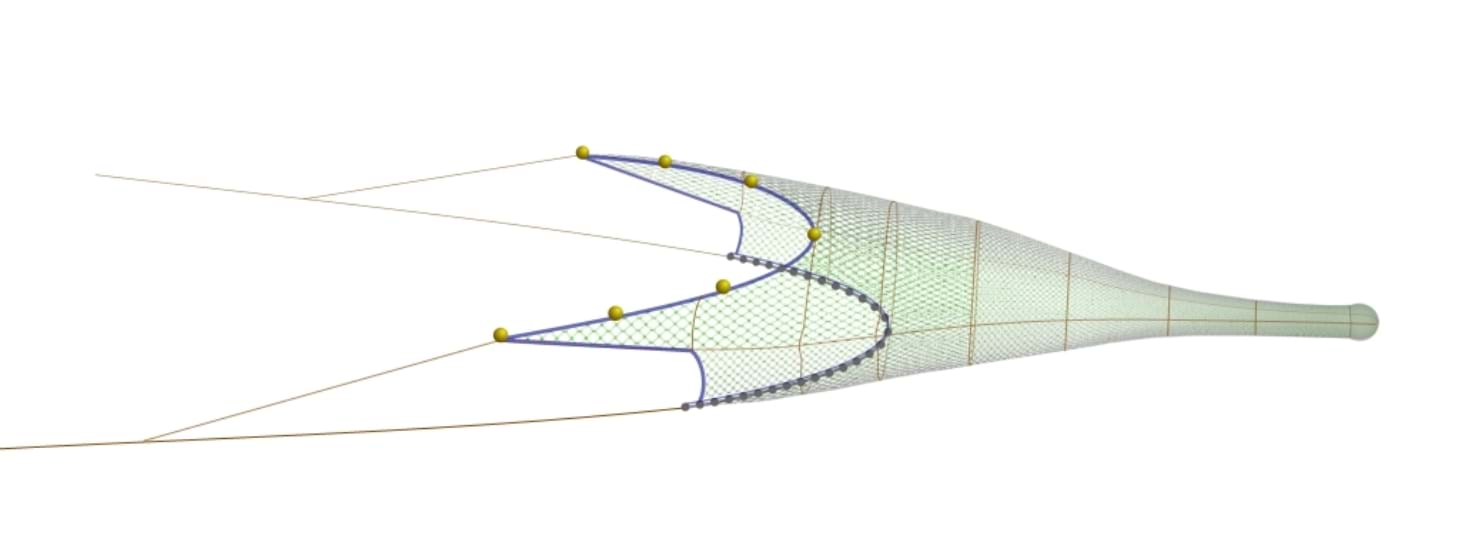Demersal Trawl - Nephrops hopper trawl
Alternative names
-
- Prawn hopper
Summary
A nephrops trawl is towed on the seabed, with the mouth held open by a pair of otter boards (trawl doors). It's designed and rigged to be towed over rough seabeds to target nephrops.

Environmental impact
Discards
Some Nephrops and prawn trawls can be susceptible to by-catch of small round fish and flat fish below the minimum conservation size due to the small mesh sizes that have to be used in these trawls to retain nephrops. Generally, compared to standard prawn trawls, prawn hopper trawls use slightly larger mesh in the trawls, the lower panel of the net stays clear of the seabed and the nets are opened up more, the meshes stay further open, and all this allows easy escape of seabed debris and small fish. They are generally towed in areas of low concentrations of other fish but still need to be fitted with legislation square mesh panels. Many of the skippers actually use square mesh panels with large mesh sizes than the regulation.
Seabed impact
As with all trawls there will be a certain degree of seabed impact with the trawl doors. When used properly the weight of any trawl door on the seabed will be much reduced compared to its weight on land. In most demersal trawl fisheries the weight of the trawl door on the seabed will be approximately 20-25% of its weight in air. This is due to several factors. One is about an 8 -10% reduction due to the weight of steel and other materials in water. The other major factor is the tension of the gear behind the trawl door and the uplift from the warp towing the trawl door. The ground gear on a nephrops hopper trawl is made up of large rubber discs spaced out using smaller rubber discs between them with it all threaded onto either wire or chain. Although this can look heavy it is quite light contact on the seabed as it is designed to 'bounce' easily over the patches of hard rough ground interspersed on the muddy seabeds of some of the nephrops grounds.
Other information
Nephrops are also known as Langoustine or Dublin Bay Prawn. In the UK, they are usually referred to as ‘prawns’ hence the name prawn net.
Nephrops usually inhabit areas of soft muddy sediments. Nephrops trawls have been developed to target nephrops on these clean soft seabeds. There are areas where nephrops live that are close to harder seabeds or where the muddy grounds are interspersed with stones and rocky out crops that would rip a standard nephrop trawl, it is these areas that a nephrops hopper trawl has been developed to fish over. The main difference is that the net is fitted with a rock hopper footrope to enable the gear to be able to tow over these 'patchy' areas. The design of the nets has altered too, the main difference is there is minimum of slack netting and the bottom panel of the gear is cut to stay clear of the seabed to prevent damage. Often there are more of the larger nephrops in these areas that increases their value to the fishermen.
Documents
-
Assessment of Stress and Mortality of the Prawn During Live Handling from Vessel to Market
-
Discard collection study comparing the SFIA designed nephrops trawl against commercial trawls
-
Economics of Quality at Sea for Nephrops - Key Features
-
Sodium Metabisulphite Alternatives
-
Sodium Metabisulphite Alternatives - key Features
-
The Effect of Icing on the Quality of Trawled Whole Nephrops
-
The Good Practice Guide for Nephrops Fishermen
-
The Swimming and Orientation Behaviour of the Norway Lobster, Nephrops norvegicus (L.), in Relation to Trawling
-
Trials of a Net Grid for the UK Nephrops trawl fisheries
-
Quality of Trawled Nephrops - Key Features
Gear classification
Main target species (UK)
-
- Nephrops
Possible bycatch
-
- Any demersal species that frequents the nephrops grounds